
A compilation of available information concerning the parasitic protozoa brooklynella hostilis. While trying to help a fellow hobbyist find information on how to treat for this parasite, it became quickly apparent that detailed information was not to be found within a singleonline search, many hours were spent to find answers to what should be considered basic questions. As such, I have done my best to compile what known facts that there are into a single page. I would like to thank Heather Ortega for her help in doing so and in providing the fish photographs shown within this page.
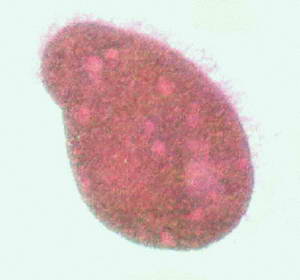
WHAT IS IT - It is a parasitic ciliated protozoan - The ciliated protozoa are the most conspicuous and easily recognized groups of
protists. They are conspicuous because they are usually motile and quite large,
ranging from an average of about 50 micrometers up to 4 mm in size. They are
easily recognized because they are propelled through the water by hundreds to
thousands of cilia (hair like structures) that cover their bodies, aligned in long files or
kineties.
METHOD OF REPRODUCTION - Reproduction occurs by simple binary
fission, in a process called conjugation where genetic material is
passed between two individuals,
much like some bacteria are able to do, The two partners usually
have to be from complementary mating types and once they have fused
they exchange gametic nuclei, which are equivalent to the nuclei of our
sperm and eggs. After this exchange, the two partners separate. The
gametic nuclei fuse and the zygotic nucleus divides. The nuclei
produced develop into a new macronucleus and a new micronucleus. This
process of reproduction occurs very rapidly and explains why an
infected fish can easily succumb to this protozoa within a matter of
hours or days. It does not have typical life cycles as other more well
known parasites, which take much longer to accomplish the same damaging
effects as seen with this one.
LIFE CYCLE - Once reproduction has taken place, the newly formed
protozoa is able to freely swim by the use of its ciliates and able to
find a new host or more usually, attach to the same fish its "parents"
are on, which is why you will note such a rapid progression of this
parasite. Attachment usually occurs at the gills of the fish first and
spreads outwards as
they multiply, as this parasite feeds upon the fish, it also releases
toxins that can prove fatal to the fish very quickly. Free swimming
protozoa can persist for quite some time without a host to feed upon.
As such, any aquarium that has had this parasite introduced to it, must
remain fallow (fishless) for no less than four weeks in order for the
remaining free swimming parasites to die off without a host to feed
upon. As such, all fish within the aquarium must be put into a quarantine tank and treated, while being kept out of the main aquarium during that four week period.
INFECTION INDICATORS - The usual first indication would show itself as
rapid breathing and loss of coloration in the head area of the fish,
followed by obvious excessive mucous sloughing off of the fish,
Excessive mucous may not be confined to the head area, it may show up
anywhere upon the fish. Scraping itself against other objects in the
tank may also be seen as the fish trys to dislodge the parasite, you
may also notice the fish has lost its appetite and remains listless or
hides constantly. Cloudy eyes may also become apparent.
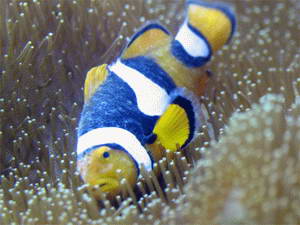
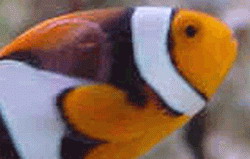
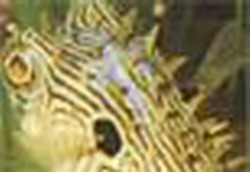
Note body mucous on all fish
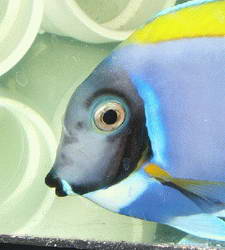


Onset - Note face coloration
Next day - Note mucous
First Treatment - Note Skin Lesion
QUARANTINE TIPS - Using a quarantine procedure not only prevents the
transmission of diseases and parasites, it is also the fish's first
chance to receive a break in its epic journey from the other side of
the planet to being in your care. Such a journey is very stressful ,
which weakens the fishes natural immunity and resistance to infections
and infestations, as well as most likely having been subjected to a
variety of pathogens along
the way. To allow the fish to recover and give itself a fighting
chance, I offer the following tips:
Removing Stress - Do not place the quarantine tank in a high traffic
area of your home, having an audience hovering over the tank is only
going to frighten the fish and increase its stress levels. Wrapping the
back and sides of the tank in a dark paper will give the fish a greater
sense of security and increase its confidence. When approaching
the tank, do so slowly so as not to spook the fish with fast movement,
if done slowly, the fish will most likely seek cover in a more relaxed
manner and not slam into any objects within the tank if rushed to hide.
Water Quality - Poor living conditions are probably the biggest cause
of stress. Within a quarantine tank, it is extremely important to
monitor ammonia levels daily if not more frequently. An ammonia alert badge
is an inexpensive way to be able to do so at a glance. Ensure all other
parameters such as temperature, PH and salinity remain within normal
ranges. Be prepared to do partial water changes if and when the need
arises.
Nutrition - It is very important to get the fish to eat as soon as
possible. All food offered to the fish should be enhanced with beta
glucan and vitamins to strengthen the fish and its immune system.
Preventive Treatment - The addition of Maracyn 2 should be standard
practice as it will help prevent opportunistic infections from gaining
ground on an already stress weakened fish. Maracyn 2 also adds vitamins
B and C to the water which may increase appetite and aid the immune
system.
In tank Structures - You should only use non-porous material to provide
hiding and sleeping areas. PVC pipe and fittings work good for this
purpose. Do not use rock or sand within a quarantine tank. It may
absorb any medications / chemicals used thus reducing the effectiveness
of any treatment. The use of plastic also ensures they can be
sterilized for future use.
TREATMENT METHODS: Formalin is the only treatment that is
effective against this parasite and it can be used with scaleless fish
also, but at half the recommended dosage.
NOTE: Ensure you understand how to set up a quarantine tank and have it
ready prior to getting a new fish, remember that ALL fish should be
placed into a quarantine tank for no less than 6 weeks, never added
straight to your show tank. The same can be said of anything that is
"wet".
MEDICATED DIP :
Formalin 3 or a 37% formaldehyde solution
: By far the most effective, and in my opinion, the only truly
effective measure that will act quick enough to defeat this parasitic
protozoa.
DO NOT add this to your show tank, this chemical will kill your
biological filter as well as any and all inverts and corals within your
tank as well as rapidly depleting the oxygen levels.
- Remove the infected fish to a quarantine tank, ensuring that the tank
is well airated as the fish may be experiencing reduced gill
efficiency.
- Treat the quarantine tank's water with Maracyn or any other
trustworthy anti-bacterial medication as a safeguard against secondary
bacterial infections as this parasite is known to cause open skin
wounds.
- Have two, one gallon clean containers filled with water from the quarantine tank that the fish has been in.
- The first one gallon container will be used for the actual dip
- The second one gallon container will be used as a rinse
to remove any of the formalin from the fish before being returned to the
quarantine tank.
- Add one or two teaspoons of Formalin 3 to one of the filled gallon
containers, this will provide a dosage of either 100ppm or 200ppm,
using the lower dosage for fish species that can be considered
delicate, such as the Tangs and Butterflys.
- An airstone MUST be used within the treatment container
with vigorous air flow as formalin will deplete oxygen levels.
- The temperature of the treatment container must not be above 80 degrees.
- Place the fish into the dip container for a period of between 30 to
60 minutes, of course the longer it can remain in the dip, the better,
but you MUST monitor the fish at all times, if the fish shows any signs
of trouble, remove the fish right away, put it into the rinse container
for a few minutes and return the fish to the quarantine tank to
recover. Do not attempt to dip the fish again until the next day.
- The fish should be dipped once a day for a five day period. If
you feel the fish is being harmed or not handling the treatment, lower
the formalin dosage used and if need be, skip a day before repeating
the dip. Do not use this as an excuse just because you feel sorry for
the fish though. The dosage and length of time within the dip, are
all things that you will have to make judgment calls on.
- While the fish is in its treatment dip, replace the two gallons of
saltwater that you removed from the quarantine tank, ensuring that the
replacement water is of the same salinity, PH and temperature as that
of the quarantine tank.
- Once the fish has been treated, remove it from the dip and place it
into the rinse container for an additional five minutes, this will
allow any medication and loosened parasites to be rinsed off of the
fish.
- After each use, both containers should be emptied into a drain ,
rinsed well with freshwater and allowed to dry until needed again.
- I would also be concerned with the quarantine tank having free
swimming parasites able to infect the fish again as it returns from its
dip, as such, I would have the quarantine tank set at hypo saline levels
( 1.009 sg ) prior to the fish being moved to the quarantine tank,
while it is usually recommended that the salinity be lowered
gradually, I feel in this circumstance, the immediate transfer to
lowered salinity levels will have a two fold benefit, in that it may
knock off alot of the parasites right away and may also kill off those
that remain free swimming in the tank between dips. A fish is much
better able to handle sudden lowered salinity than going into higher
salinity. Any "shock" concerns would be minimum. Most large
wholesalers and public aquariums place their new arrivals directly into
hypo saline conditions upon arrival with little, if any, losses.
Two Tank Method to prevent reinfestation :
- Since there is a concern about returning a newly dipped fish back
into the quarantine tank's water, which may allow the reinfection of
the fish, having two tanks in use could avoid such a chance. One of the
two tanks would be drained and sterilized after the removal of the fish
and filled again with new saltwater, rotating between the two tanks and
sterilizing each as the fish are removed for treatment.
LONG TERM BATH :
- If you feel that you have caught this parasite in its earliest
stages, or are not sure of which parasite may be infesting the fish, a
long term treatment bath can be used also, this treatment plan should
be used if you feel the fish is so weakened or has an unusual risk
involved with the dip method. This method may also be more effective
when having to treat all of your fish at one time due to the main tank
being infested.
- A quarantine tank has to be used also for this treatment method, formalin should never be used within the main aquarium.
- The salinity of the quarantine tank does not have to be lowered to hypo saline conditions.
- Aeration should be vigorous within the quarantine tank.
- The fish will have to remain within this quarantine tank for no less
than eight weeks if they have been in the main tank to allow the main
tank to remain fishless for that time period to ensure any remaining
parasites die off from the lack of a host fish.
- With the quarantine tank
set up as suggested / linked to, Add one to two teaspoons of Formalin 3
to each 10 gallons of water. Using the lower or higher dosage depending
on the sensitivity and / or the condition of the fish to be treated.
- Every 24 hours, change 25 percent of the quarantine tank's water and add another dose of formalin 3.
- Continue the treatment for a five day period. Continue to do daily
water changes after the four day treatment to control the inevitable
ammonia issues.
Note : Amquel plus can be used in conjunction with Formalin 3 to control or lock up ammonia.
- Formaldehyde persists for only a few hours in aquariums and does not accumulate in the water
Notes / Concerns : Formalin is a poison , as such it should be
treated and handled as you would any dangerous chemical. Please follow
closely any directions by the manufacturer for its proper handling,
storage and disposal.
Alternative Formalin use : If you feel the infested fish may not be
able to handle long term dip methods, you may want to consider using a
combination of both dip and long term bath methods, in that, give the
fish a one time dip treatment to knock down and remove the infestation
and then place the fish into a long term bath treatment to kill any
remaining parasites. I would only do this with a heavily infested fish
that could be considered a sensitive species or one that is already
weakened by the parasite.
Hypo salinity - This is not an effective treatment, while lowered
salinity may allow the protozoa to drop off of the fish, it is no
guarantee that all will do so and you risk losing the fish if any
remain and are able to rapidly multiply again. The speed at which this
protozoa can multiply requires fast, effective treatment. At which hypo
salinity methods may take too long to become effective before the
possible loss of the fish.
Copper based treatments - Not found to be effective against this particular parasite.
Freshwater Dips - Not found to be effective, although it may provide
temporary relief or used as a method to knock off as many of the
parasites as possible before the fish is placed into a long term
bathtreatment.